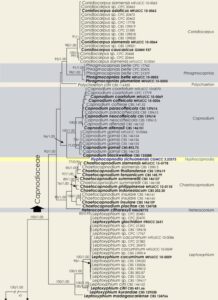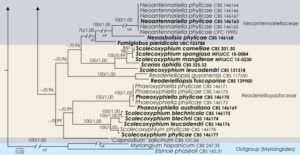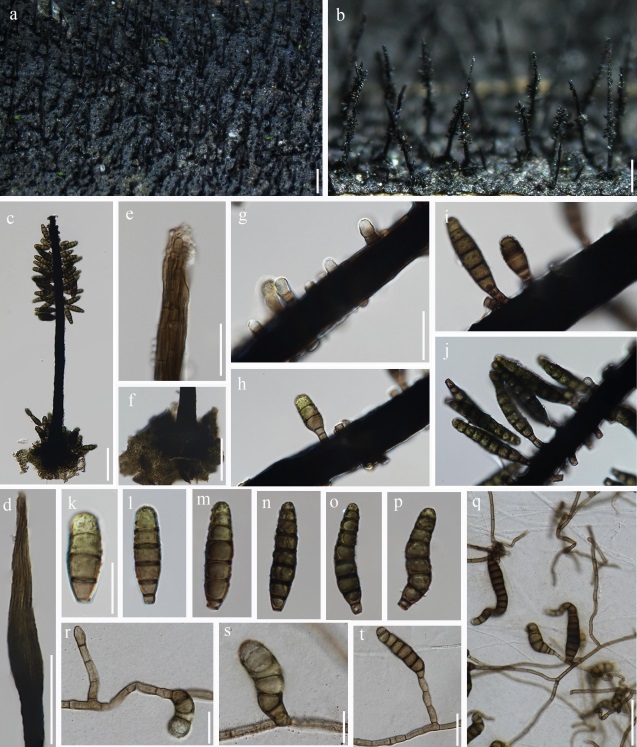Hyphocapnodia sichuanensis Z. H. Lu, Wanas., Madrid & Maharachch., in Lu, Wanasinghe, Madrid & Maharachchikumbura, Phytotaxa 564(1): 90 (2022)
Index Fungorum Number: IF 845350; FacesofFungi number: FoF 15611
Etymology: Named after the Sichuan Province, where it was collected.
Saprobic on living and decaying branches of an unidentified bamboo. Sexual morph: not observed. Asexual morph: hyphomycetous. Colonies on the natural substrate effuse, hairy, black, developing on the upper side of branches of the host. Mycelium immersed and superficial, forming dark brown stromata. Conidiomata synnematous, erect, subcylindrical, dark brown to black, 980–1500 µm tall, 15.5–24 µm wide at the apex, 30–50 µm wide at the base, with conidiogenous cells distributed mostly towards the upper half of the synnemata. Conidiophores macronematous, simple, dark brown, smooth to verruculose 900–1300 × 2–5 µm. Conidiogenous cells mostly lateral, monoblastic, (sub)cylindrical, integrated, determinate, smooth, 2–5 × 2–4 µm. Conidia subcylindrical to fusiform, straight to slightly curved or sigmoid, dark brown, verrucose, with an obtuse apex and a truncate base, dark brown at maturity, 38.5–51 × 10–15 µm (x̅ = 44 × 11.9 µm), with up to 8 transverse septa, conidial secession schizolytic. Germination occurs from the apical cell of the conidia.
Culture characteristics – Colonies on PDA slow-growing, reaching 2 cm diam. in 3 weeks, irregular, superficial to erumpent, black, raised centrally and wrinkled, with an undulate margin, reverse black
Material examined – CHINA, Sichuan Province, Chengdu city, Bai Yun Gou, on dead branches of Bambusaceae, 27 September 2021, 30°47.52′ N, 103°24.19′ E, elev.: 990 m. Lu Z-H, HUEST 22.0031 (HKAS 124021, holotype), ex-type living culture CGMCC 3.23573 = UESTCC 22.0031.
Notes – In BLASTn searches with the ITS sequence of this fungus, the closest hits were Polychaeton citri (strain CBS 116435, GenBank OM238161; Identities = 568/596 (95%), 9 gaps (1 %)), Conidiocarpus caucasicus (voucher UBCF23755, GenBank KF263962; Identities = 535/564 (95%), 9 gaps (1 %)), and Capnodium sp. (strain TMS-2011, GenBank HQ631045; Identities = 532/563 (94%), 8 gaps (1 %)). Based on morphology and sequence data, Hyphocapnodia is clearly distinct from the other members of the Capnodiaceae. In vitro, this fungus showed a remarkably different morphology, characterized by the absence of synnemata and micronematous conidiophores giving rise to conidia 55–132 × 9–16 µm (x̅ = 89.9 × 12.5 µm, n =16), which often appeared sinuous and showed up to 14 septa (mostly 5–10).

FIGURE 1. RAxML tree based on a combined dataset of partial LSU, ITS, tef1-α and rpb2 sequences of members of the order Capnodiales. Bootstrap support values for ML (MLB) ≥ 70 %, Bayesian posterior probabilities (BYPP) values ≥ 0.95 are shown as MLB/BYPP above the nodes. Ex-type strains are in black bold, and the new strain generated in this study is in blue bold. The scale bar represents the expected number of nucleotide substitutions per site. Elsinoë phaseoli (CBS 165.31) and Myriangium hispanicum (CBS 247.33) were selected as outgroup taxa.

FIGURE 1. Continued.

FIGURE 2. Hyphocapnodia sichuanensis (HKAS 124021, holotype). a, b. Synnemata on the natural substrate; c. Synnema; d, e. Upper part of the synnema; f. Basal part of a synnema; g–j. Conidia attached to conidiophores; k–p. Conidia in various stages of maturation; q–t. Conidia obtained in culture; Scale bars: a = 1000 µm, b = 250 µm, c–f, r–t = 10 µm, g, q = 20 µm. k = 15 µm, Scale bars of g applies to g–j, Scale bars of k applies to k–p
